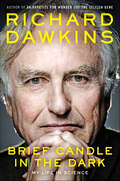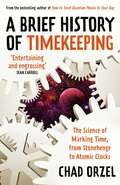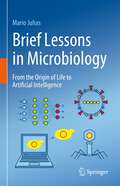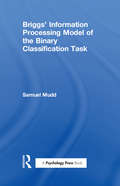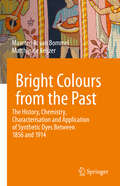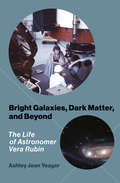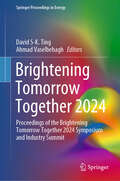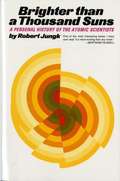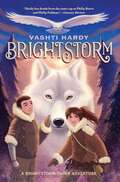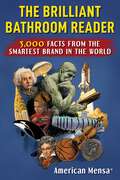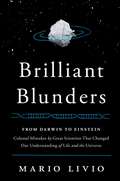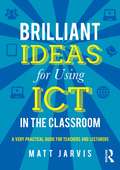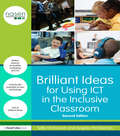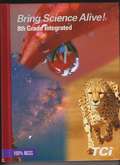- Table View
- List View
Brief Candle in the Dark: My Life in Science
by Richard DawkinsIn this hugely entertaining sequel to the New York Times bestselling memoir An Appetite for Wonder, Richard Dawkins delves deeply into his intellectual life spent kick-starting new conversations about science, culture, and religion and writing yet another of the most audacious and widely read books of the twentieth century—The God Delusion.Called “one of the best nonfiction writers alive today” (Stephen Pinker) and a “prize-fighter” (Nature), Richard Dawkins cheerfully, mischievously, looks back on a lifetime of tireless intellectual adventure and engagement. Exploring the halls of intellectual inquiry and stardom he encountered after the publication of his seminal work, The Selfish Gene; affectionately lampooning the world of academia, publishing, and television; and studding the pages with funny stories about the great men and women he’s known, Dawkins offers a candid look at the events and ideas that encouraged him to shift his attention to the intersection of culture, religion, and science. He also invites the reader to look more closely at the brilliant succession of ten influential books that grew naturally out of his busy life, highlighting the ideas that connect them and excavating their origins.On the publication of his tenth book, the smash hit, The God Delusion, a “resounding trumpet blast for truth” (Matt Ridley), Richard Dawkins was catapulted from mere intellectual stardom into a circle of celebrity thinkers dubbed, “The New Atheists”—including Christopher Hitchens, Sam Harris, and Daniel Dennett.Throughout A Brief Candle in the Dark, Dawkins shares with us his infectious sense of wonder at the natural world, his enjoyment of the absurdities of human interaction, and his bracing awareness of life’s brevity: all of which have made a deep imprint on our culture.
Brief History of Herpetology in the Museum of Vertebrate Zoology, University of California, Berkeley, with a List of Type Specimens of Amphibians and Reptiles
by Javier A. Rodriguez-Robles David A. Good David B. WakeThis monograph offers a brief account of the principal figures associated with the collection and of the most important events in the history of herpetology in the MVZ during its first 93 years, and lists all type specimens of recent amphibians and non-avian reptiles in the collection.
Brief History of Timekeeping: The Science of Marking Time, from Stonehenge to Atomic Clocks
by Chad Orzel&‘Entertaining and engrossing&’ Sean Carroll Press the snooze button on your alarm once too often and you soon remember the importance of good timekeeping. That need to tell the time connects you to over five thousand years of human history, from the first solstice markers at Newgrange to quartz crystal oscillating in your watch today. Science underpins time: measuring the movement of Sun, Earth and Moon, and unlocking the mysteries of quantum mechanics and relativity theory – the key to ultra-precise atomic clocks. Yet time is also socially decided: the Gregorian calendar we use today came out of fraught politics, while the ancient Maya used sophisticated astronomical observations to produce a calendar system unlike any other. In his quirky and accessible style, Chad Orzel reveals the wondrous physics that makes time something we can set, measure and know.
Brief Introduction to Fisheries
by Xinjun Chen Yingqi ZhouThis book offers an introduction to aquaculture sciences and fisheries, discussing the concepts and basic characteristics of fisheries, fishery resources and the related industries, as well as the status of fisheries in various countries around the globe. The book also examines aquaculture, aquatic product processing and utilization, fishery information technology, and fishery economics and management, in addition to hot topics such as blue growth in fisheries, carbon sink fisheries, and global environmental changes in the context of fisheries. Given its scope, it is a valuable resource for undergraduate students in the field as well professional requiring a basic understanding of fisheries.
Brief Lessons in Microbiology: From the Origin of Life to Artificial Intelligence
by Mario JuhasRecent discoveries in microbiology are hard to grasp for those unfamiliar with scientific jargon, and the research data can be overwhelming even for those working in other scientific fields. This book aims to remedy this situation by presenting the most interesting findings and current trends in microbiology in an easy-to-read and understandable format. The first part tells the story of the beginnings of microbiology itself and introduces the reader to the founders of this fascinating research discipline. The second part focuses on communication between microorganisms and how they organize themselves into fascinating microbial cities called “biofilms”. The reader also learns how bacteria exchange genetic material - mechanisms that are the root of the emergence of multidrug-resistant superbugs, pathogens that pose a major burden to human health and our healthcare systems. The third part is devoted to the latest techniques being used by scientists to study, control, and manipulate microorganisms for our benefit. The final part links the first three parts together and highlights how infectious diseases, including coronaviruses, can be transmitted from animals to humans, how global warming is affecting emerging diseases, and provides information on the actions that need to be taken to get ahead of pathogenic microbes and future pandemics. This comprehensive, state-of-the-art book is intended for anyone interested in microbiology and epidemiology, from biology and biomedical students in schools and colleges, to patients suffering from infectious diseases who want to learn more about their condition. The concepts covered in this book contribute to UN Sustainable Development Goal 3: Health and Well-Being.
Briefe und Tagebuchaufzeichnungen Willy Kükenthals von seiner Reise in den Malaiischen Archipel 1893–1894
by Sybille BauerIn diesem Buch finden Sie die von Willy Kükenthal, dem berühmten deutschen Zoologen und Forschungsreisenden, erhaltenen Briefe, die er während seiner Reise in den Malaiischen Archipel Ende des 19. Jahrhunderts an seine Frau geschrieben hat und ein auf Borneo geführtes wissenschaftliches Tagebuch. Giftmischende Malayen auf Halmahera, kopfjagende Alfuren in Borneo, Fiebersümpfe, Moskitoschwärme und Blutegel – über fast alles hat er seine Frau, wenn auch oft diplomatisch, in Kenntnis gesetzt. Die Methoden der Penisperforation jedoch vertraute er nur seinem Tagebuch. an. Die Dokumente seiner Reise geben einen Einblick in die Erfahrungen, die Willy Kükenthal während seiner Abenteuer in Südostasien gemacht hat. Sie sind ein eindrucksvolles Zeugnis der Forschung im 19. Jahrhundert. Die Briefe und das Tagebuch zeigen, unter welch extremen Bedingungen Zoologen aus Kükenthals Generation forschten, um Sammlungen für Museen zusammenzustellten.
Briggs' Information Processing Model of the Binary Classification Task
by S. MuddFirst published in 1983. Routledge is an imprint of Taylor & Francis, an informa company. This monograph is a review of the evolution of George Briggs’ informationprocessing model from a general schema beginning with the work of Saul Sternberg (1969a) and Edward E. Smith (1968) to a fairly well-detailed schematic representation of central processes that Briggs was working on at the time of his early death. The development of Briggs’ model of the binary classification task (BCT) spanned the period from 1969 when he published his first report on choice reaction time with Blaha (Briggs & Blaha, 1969) to 1977 with the publication of a posthumous paper (Briggs, Thomason, & Hagman, 1978). The model evolved across a total of 16 experimental and 2 review papers.
Bright Colours from the Past: The History, Chemistry, Characterisation and Application of Synthetic Dyes Between 1856 and 1914 (Cultural Heritage Science)
by Matthijs de Keijzer Maarten R. van BommelThe invention of Mauveine by Perkin in 1856 led to a revolution in the world of textile dyeing. In the second half of the 19th century, natural dyes were quickly replaced by newly developed synthetic dyes which resulted in a bright palette of colours. The synthetic dyes were not only cheaper to produce, but also easier to apply on textiles due to new dyeing mechanisms. As a result, production costs decreased tremendously and brilliantly dyed textiles became available to the larger public. The introduction of synthetic dyes had a strong impact in fashion; in addition, these colourants were also used as stains on furniture, as inks and in paints. In this publication, the development of these vivid colourants is presented. It brings together information about the history of synthetic dyes, including the first attempts, the so-called semi-synthetic dyes, and presenting the most relevant dyes and dye classes, such as nitro dyes, tri-arylmethanes, azo dyes, xanthenes, sulfur dyes, synthetic alizarin and synthetic indigo. It contains a wealth of information regarding the numerous synonyms, trade names, manufacturers and patents. International trade and competition, which was fierce, are discussed. The chemistry behind the synthetic dyeing is explained, including new dyeing technologies developed. The application of dyes and their fastness properties are also presented. An overview of analytical techniques used for characterisation is given. Many case studies are included, expressing the importance of the dyes and the creativity of mankind when applying these colourants. As such, this publication can be seen as a colourful journey through history, relevant for conservators, curators, historians, chemists and all who are interested in the history and development of synthetic dyes.
Bright Dreams: The Brilliant Inventions of Nikola Tesla
by Tracy DockrayYoung Nikola Tesla got a shock when he rubbed his cat's fur. That small spark lit his imagination forever. Covering his early years to his eventual success in the world of electricity, Bright Dreams showcases Tesla's incredible journey of discovery and perseverance. Author-illustrator Tracy Dockray conveys Tesla's busy and imaginative world with collage-style artwork and informative sidebars.
Bright Galaxies, Dark Matter, and Beyond: The Life of Astronomer Vera Rubin
by Ashley Jean YeagerHow Vera Rubin convinced the scientific community that dark matter might exist, persevering despite early dismissals of her work. We now know that the universe is mostly dark, made up of particles and forces that are undetectable even by our most powerful telescopes. The discovery of the possible existence of dark matter and dark energy signaled a Copernican-like revolution in astronomy: not only are we not the center of the universe, neither is the stuff of which we&’re made. Astronomer Vera Rubin (1928–2016) played a pivotal role in this discovery. By showing that some astronomical objects seem to defy gravity&’s grip, Rubin helped convince the scientific community of the possibility of dark matter. In Bright Galaxies, Dark Matter, and Beyond, Ashley Jean Yeager tells the story of Rubin&’s life and work, recounting her persistence despite early dismissals of her work and widespread sexism in science. Yeager describes Rubin&’s childhood fascination with stars, her education at Vassar and Cornell, and her marriage to a fellow scientist. At first, Rubin wasn&’t taken seriously; she was a rarity, a woman in science, and her findings seemed almost incredible. Some observatories in midcentury America restricted women from using their large telescopes; Rubin was unable to collect her own data until a decade after she had earned her PhD. Still, she continued her groundbreaking work, driving a scientific revolution. She received the National Medal of Science in 1993, but never the Nobel Prize—perhaps overlooked because of her gender. She&’s since been memorialized with a ridge on Mars, an asteroid, a galaxy, and most recently, the Vera C. Rubin Observatory—the first national observatory named after a woman.
Bright Splinters of the Mind: A Personal story of research with Autistic Savants
by Beate HermelinThe author describes a series of studies which she and her colleagues have conducted in an attempt to gain a deeper understanding of autistic savant syndrome. Her subjects include children and adults with autism who have remarkable abilities in music, art, mathematics, foreign languages, and calendar calculation. Hermelin suggests that people with autism perceive detail before recognizing an integrated whole. This is a very readable book with a strong scholarly foundation.
Brightening Tomorrow Together 2024: Proceedings of the Brightening Tomorrow Together 2024 Symposium and Industry Summit (Springer Proceedings in Energy)
by David S-K. Ting Ahmad VaselbehaghThis book includes the proceedings of the Symposium and Industry Summit, June 20-21, 2024 at University of Windsor Negativity and pessimism seem to dominate the media in recent years, overshadowing the bright side of our beautiful planet and disheartening its inhabitants. Not to deny the prevailing challenges, but tomorrow is far from complete ruin and doom. Brightening Tomorrow Together aims at bringing optimists from many disciplines of expertise and walks of life together to synergise existing know-how and further the latest technologies and measures to hasten the brightening of tomorrow. This book is part of the big dream of the Turbulence and Energy Laboratory. It strives to bring together a diverse group to exchange state-of-the-art progresses and to promote collaborations across different disciplines to hasten the brightening of tomorrow together. Topics of interest include engineering cleaner energy, improving our understandings of water and wastewater, reducing waste and pollution at all fronts, and actualizing eco-friendly agriculture and living.
Brighter Than a Thousand Suns: A Personal History of the Atomic Scientists
by Robert Jungk James CleughAn account of the remarkable scientists who discovered that nuclear fission was possible and then became concerned about its implications. Index. Translated by James Cleugh.
Brightstorm: A Sky-ship Adventure (Brightstorm #1)
by Vashti HardyCritically acclaimed in the UK, Brightstorm is a fast-paced fantasy adventure novel that will set imaginations soaring. Arthur and Maudie Brightstorm receive devastating news: their famous explorer father has died in a failed attempt to reach South Polaris. To make matters worse, the Lontown Geographical Society finds Ernest Brightstorm guilty of sabotaging the expedition of his competitor, Eudora Vane. But a mysterious clue leads the twins to question the story they’ve been told—and to uncover the truth, they must undertake the journey of a lifetime. Joining the ragtag crew of a homemade sky-ship captained by the intrepid Harriet Culpepper, Arthur and Maudie race to South Polaris to salvage their family’s reputation and find out what really happened on their father’s doomed expedition. Brightstorm is a propulsive and compelling fantasy adventure set among the vibrant landscapes and dynamic characters of Vashti Hardy’s vividly imagined world.
Brilliant Bathroom Reader (Mensa®): 5,000 Facts from the Smartest Brand in the World
by American MensaAmerican Mensa presents: The Brilliant Bathroom Reader—The ultimate book of 5,000 facts curated by the world's smartest brand. Perfect to expand any curious mind! Whether gearing up for a big trivia night or simply wanting to give your brain something interesting to think about, this big book of 5,000 facts from the smartest brand in the world fits the bill. These facts will make you think. They&’ll make you wonder. You may even want to research more about some of these topics. Most of all, you&’ll have a ton of fun learning about everything from Thomas Edison&’s attempts at mind reading to Dr. Lucy King&’s beehive fences that scare elephants from destroying farms. We cover as many topics as possible, including facts that got our attention while weeding out the stuff that made us yawn or go, &“Yeah, yeah, I&’ve heard that one a million times.&” Topics include: Flora, Fauna, and FungaScience and TechnologyWorld CultureHistory US PresidentsNational ParksArt, Fashion, and LiteratureArchitectureHealthComicsMusic and EntertainmentSports and LeisureBizarre but TrueThe Brilliant Bathroom Reader is the perfect gift for learning new and exciting facts whenever you have a spare moment or two.
Brilliant Blunders: From Darwin to Einstein - Colossal Mistakes by Great Scientists That Changed Our Understanding of Life and the Universe
by Mario LivioDrawing on the lives of five great scientists, this “scholarly, insightful, and beautifully written book” (Martin Rees, author of From Here to Infinity) illuminates the path to scientific discovery.Charles Darwin, William Thomson (Lord Kelvin), Linus Pauling, Fred Hoyle, and Albert Einstein all made groundbreaking contributions to their fields—but each also stumbled badly. Darwin’s theory of natural selection shouldn’t have worked, according to the prevailing beliefs of his time. Lord Kelvin gravely miscalculated the age of the earth. Linus Pauling, the world’s premier chemist, constructed an erroneous model for DNA in his haste to beat the competition to publication. Astrophysicist Fred Hoyle dismissed the idea of a “Big Bang” origin to the universe (ironically, the caustic name he gave to this event endured long after his erroneous objections were disproven). And Albert Einstein speculated incorrectly about the forces of the universe—and that speculation opened the door to brilliant conceptual leaps. As Mario Livio luminously explains in this “thoughtful meditation on the course of science itself” (The New York Times Book Review), these five scientists expanded our knowledge of life on earth, the evolution of the earth, and the evolution of the universe, despite and because of their errors. “Thoughtful, well-researched, and beautifully written” (The Washington Post), Brilliant Blunders is a wonderfully insightful examination of the psychology of five fascinating scientists—and the mistakes as well as the achievements that made them famous.
Brilliant Green: The Surprising History and Science of Plant Intelligence
by Michael Pollan Stefano Mancuso Alessandra ViolaAre plants intelligent? Can they solve problems, communicate, and navigate their surroundings? Or are they passive, incapable of independent action or social behavior? Philosophers and scientists have pondered these questions since ancient Greece, most often concluding that plants are unthinking and inert: they are too silent, too sedentary -- just too different from us. Yet discoveries over the past fifty years have challenged these ideas, shedding new light on the extraordinary capabilities and complex interior lives of plants. In Brilliant Green, Stefano Mancuso, a leading scientist and founder of the field of plant neurobiology, presents a new paradigm in our understanding of the vegetal world. Combining a historical perspective with the latest in plant science, Mancuso argues that, due to cultural prejudices and human arrogance, we continue to underestimate plants. In fact, they process information, sleep, remember, and signal to one another -- showing that, far from passive machines, plants are intelligent and aware. Through a survey of plant capabilities from sight and touch to communication, Mancuso challenges our notion of intelligence, presenting a vision of plant life that is more sophisticated than most imagine. Plants have much to teach us, from network building to innovations in robotics and man-made materials -- but only if we understand more about how they live. Part botany lesson, part manifesto, Brilliant Green is an engaging and passionate examination of the inner workings of the plant kingdom. Financial support for the translation of this book has been provided by SEPS: Segretariato Europeo Per Le Pubblicazioni Scientifiche.
Brilliant Ideas for Using ICT in the Classroom: A very practical guide for teachers and lecturers
by Matt JarvisBrilliant Ideas for Using ICT in the Classroom is a totally practical, hands-on guide to using ICT in and around the classroom for all secondary school teachers and lecturers in post-compulsory education. Assuming no prior expertise, it centres on software and resources that are free or very low cost, and offers step-by-step guidance and creative ideas to improve the experience and engagement of your students. With a focus on what tools to use, what educational need they satisfy and how to incorporate them into good pedagogy, key topics covered include: Effective use of presentation technologies Using, producing and sharing multimedia Interactive whiteboards and related technologies Using Web 2.0 technologies Mobile learning Supporting diverse student needs through technology. Brilliant Ideas for Using ICT in the Classroom puts equal emphasis on both technical and pedagogical issues, making it the ideal companion whatever your ICT or e-learning needs. Catering equally well for Windows, Mac and Linux users, this book is designed to give you all the confidence you need to start teaching brilliantly with ICT.
Brilliant Ideas for Using ICT in the Inclusive Classroom (David Fulton / Nasen Ser.)
by Sally McKeown Angela McGlashonRunner up in Teach Secondary’s Technology and Innovation Awards 2014 sponsored by Lego, Brilliant Ideas for using ICT in the Inclusive Classroom provides lots of simple practical ideas showing teachers and support staff how they can use ICT to boost the achievement of all pupils. How can you use ICT to boost the achievement of all your pupils? This practical teachers’ guide will help you to unlock the enormous potential of new technology in order to enhance pupils’ learning, particularly for young people with additional needs. Written by two of the UK’s leading technology experts, this invaluable and newly updated resource will enable you to use ICT effectively to make lessons more accessible, motivating and fun. With fifty illustrated case studies and twenty starter activities, this practical resource will help you to introduce new technology into the inclusive classroom. It has been specifically designed to help develop your pupils’ key skills, such as problem solving, developing concepts and communicating to different audiences. In each activity, the authors show why and how a particular resource was used and show how similar techniques can be implemented to open up the curriculum to your learners. The authors include timely and realistic advice on how to use a range of technologies from the cheap and cheerful – and even free – to more sophisticated and specialist packages. Find out about: Apps Blogging Digital animation Podcasting Digital storytelling Wikis Geocaching Coding Games and gaming Sat nav Art packages Twitter Whether you’re already techno-savvy or looking to get started with ICT, this book is full of brilliant ideas on how to engage learners of all abilities using technology. If you’re looking for inspiration on how to integrate creative uses of ICT with the curriculum, this book will prove invaluable.
Brilliant!
by Bob JohnstoneA revolution in the way we use artificial lighting is underway, one that is every bit as sweeping and significant as Edison's invention of the light bulb. The technology of light emitting diodes (LEDs) is ready for widespread implementation. Its impacts will include a reduction in energy consumption for electric lighting by up to 80 percent.Brilliant! tells the story of Shuji Nakamura, a gifted Japanese engineer who came out of nowhere to stun the world with his announcement that he had created the last piece in the puzzle needed for manufacturing solid-state white lights. The invention of this holy-grail product, which promises to make Edison's light bulb obsolete, had eluded the best minds at the top electronic firms for twenty-five years. Until his startling announcement, Nakamura had not even been on the radar screen of most industry observers. Veteran technology writer Bob Johnstone traces the career of Nakamura, which included many years of obstinate individual effort as well as a dramatic legal battle pitting him against his former Japanese employer. Over a five-year span, Nakamura distinguished himself with an unprecedented series of inventions--bright blue, green, ultraviolet, and then white LEDs, plus a blue laser that will play an essential role in the next-generation DVD players. Then he was forced to leave Nichia Chemical, the company where he had worked for twenty years, and his former employer sued him. The result was a multimillion-dollar settlement in a landmark decision that acknowledged, for the first time, the rights of individual inventors working in a corporate context. Today, Nakamura holds a professor's chair at the University of California at Santa Barbara, where he continues to develop the technology of LEDs. Johnstone, the first Western journalist to meet and interview Nakamura, has received the brilliant engineer's full cooperation through a series of exclusive interviews given for the book. Johnstone has also interviewed other key players in the imminent lighting revolution, providing an exciting preview of the technological, entrepreneurial, and artistic creativity that will soon be unleashed by Nakamura's inventions.
Bring Science Alive!
by Teachers’ Curriculum InstituteNIMAC-sourced textbook <p> 7th Grade, Integrated
Bring Science Alive! 8th Grade Integrated (Interactive Student Notebook ##2)
by Teachers' Curriculum InstituteThe print consumable Interactive Student Notebook provides students a place to record observations, graph data, construct arguments, and more during investigations and engineering challenges. <P> Notebook 2 of 2.
Bring Science Alive! 8th Grade Integrated (Interactive Student Notebook #1)
by Teachers' Curriculum InstituteThe print consumable Interactive Student Notebook provides students a place to record observations, graph data, construct arguments, and more during investigations and engineering challenges. <P> Notebook 1 of 2.
